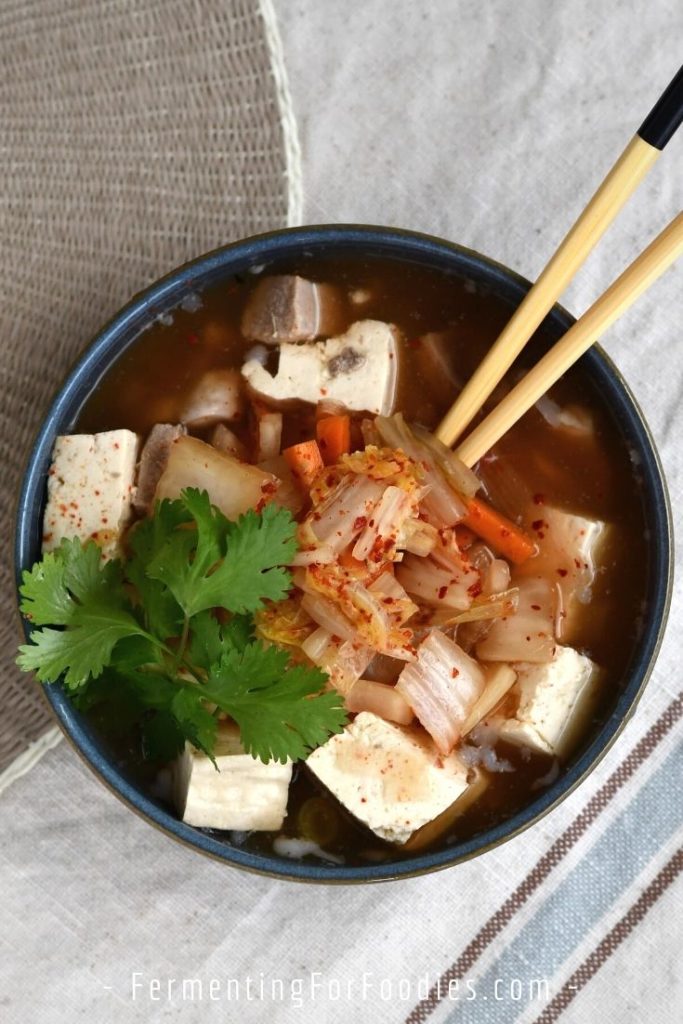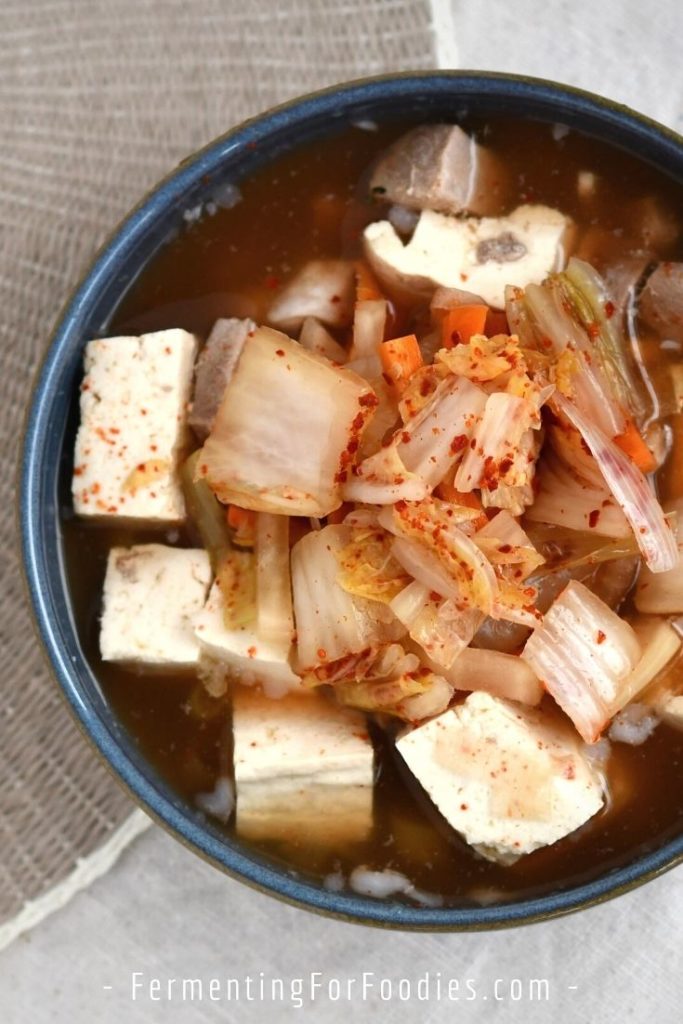Kimchi is an incredibly versatile condiment that adds a burst of flavor to most meals. This pork belly kimchi soup is quick, easy, and delicious! Perfect for a busy weeknight dinner.

This soup is designed to use up sour kimchi (kimchi that is more than 5 days). Using kimchi for vegetables and flavor reduces the prep time, making it a quick, 30-minute meal.
Since kimchi is probiotic and prebiotic, it is also a good way to feed your microbiome!
While most of my recipes are vegetarian, this soup is definitely not. If you’re looking for a meat-free meal, check out my vegan kimchi soup. It’s a meatless version of this traditional recipe.
Create A Signature Soup
Pork belly kimchi soup is the perfect base for your own signature kimchi-inspired soup.
- Low carb: If you skip the tofu, then this soup is keto, paleo, and low carb. If you are super strict about your low-carb diet, then you’ll want to make homemade kimchi without carrots. However, fermentation reduces the carbs in all vegetables, so store-bought kimchi is probably just fine.
- Noodle bowl: Turn this soup into a filling noodle bowl by adding a 200g package of rice noodles or buckwheat soba noodles to the soup pot for the final 10 minutes of cooking.
- Rice bowl: Feel free to serve the soup over a bowl of rice.
- Just the right spice: Traditional kimchi is quite spicy. However, it doesn’t have to be! Make this soup kid-friendly by using non-spicy vegetarian kimchi.
- No kimchi: Not a fan of kimchi? Then use two cups of diced vegetables, adding them during the last 5 minutes of boiling. I recommend carrots, sweet peas and broccoli.

Pork Belly Kimchi Soup
This quick and easy pork belly kimchi soup is warming and delicious. It is perfect for a busy weeknight dinner. See the suggestions above for taking this simple recipe and turning it into a keto-friendly soup or a kid-friendly noodle bowl!
- Prep Time: 10 minutes
- Cook Time: 30 minutes
- Total Time: 40 minutes
- Yield: Serves 3-4 1x
- Category: Soup
- Cuisine: Korean
- Diet: Gluten Free
Ingredients
- 1/2 lbs pork belly
- 2 spring onions
- 2 garlic cloves
- 1 package of firm tofu (about 12 oz / 350 g)
- 5 cups of water
- 3 Tbsp soy sauce (or GF alternative)
- 2 cups of kimchi brine (see notes)
- 3 cups of kimchi vegetables
Instructions
- Slice the pork belly into bite-sized strips. Dice the spring onions and garlic. Cut the tofu into bite-sized cubes.
- Put the water, pork belly, spring onions, garlic, soy sauce, and tofu into a large pot.
- Bring to a boil, reduce the heat, and simmer for 30 minutes with the lid on.
- After 30 minutes, add the kimchi brine. Taste and add salt, if necessary. I have never felt the need for additional salt, which is why it isn’t on the ingredient list.
- To cook the kimchi stir it into the boiling broth and let it cook for 5 minutes before serving. This will help to mellow out the flavors of the ginger, garlic, and onions.
- For a probiotic soup serve the soup first, then add a spoonful of kimchi on top of each bowl.
Notes
- Depending on the method used to make kimchi, you may not have brine. Traditional recipes don’t usually involve making brine. However, I typically make a brine because it’s the simplest way to ensure a good, no-fuss ferment. Adding brine is optional. If you don’t have brine, simply add more water and a bit of salt, if needed.
- See the section above for how to add noodles to turn this soup into a noodle bowl instead.
Nutrition
- Serving Size: 3 cup bowl
- Calories: 352
- Sugar: 3.1g
- Sodium: 4718mg
- Fat: 20.2g
- Saturated Fat: 7.1g
- Carbohydrates: 29g
- Fiber: 3.2g
- Protein: 14.2g
- Cholesterol: 25mg



This is a great dish.
Thanks!